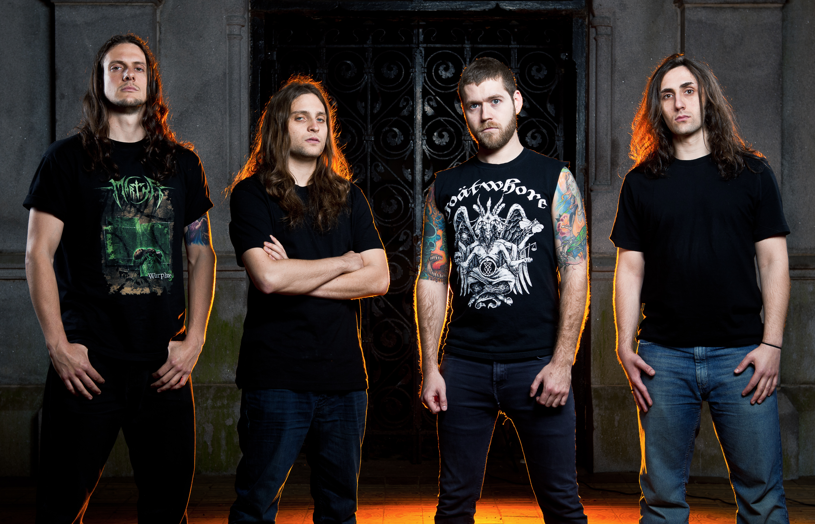Thrash Course with Dave Davidson: Using Minor-Seven Flat-Five Chords in Metal

One of my prime objectives when writing music for my band Revocation is to try to push the envelope and come up with sounds, ideas, chord patterns, progressions and riffs that have been rarely explored within the thrash metal genre.
A good way to do this is to use seventh chords, which are rarely heard in metal. This month, I’d like to demonstrate a few cool ways one can use one particularly cool- and tense-sounding seventh chord in heavy, thrash-style riffs.
Of the different types of seventh chords—major-seven, dominant-seven, minor-seven and what have you—the one that appeals to me most is minor-seven-flat-five (m7b5), also known as half-diminished-seven. If you are unfamiliar with this chord type, it’s helpful to start with a regular minor-seven chord, like the Cm7 voicing shown in Figure 1, then alter it. First, strum the entire chord, then pick out each note individually. In the Cm7 voicing illustrated here, the chord tones are, low to high, C, the root; G, the fifth; Bb, the minor, or “flat,” seventh (b7); and Eb, the minor, or “flat” third (b3). If we lower the fifth, G, by one half step, to Gb (or F#), we get the Cm7f5 voicing depicted in Figure 2. Again, pick the notes of the chord individually, then strum them together. Our chord-tone “stack” is now, low to high, C, the root; Gb, the diminished, or “flat,” fifth (b5); Bf, the minor, or “flat,” seventh (b7); and Eb, the minor, or “flat” third (b3). You’ll notice that this chord sounds much more tense than Cm7.
The “flat-five” sound has been a staple of metal from the very beginning, a prime example being the intro to the song “Black Sabbath,” the opening track on Black Sabbath’s debut album. Tony Iommi plays a G octave followed by a trilled Db, which is the flatted fifth, or “flat five,” of G. The root/flat-five interval, by the way, is formally known as a tritone, so called because flatted fifth is three whole tones above or below the root.
Now that we’re familiar with a standard Cm7f5 voicing, the next thing to do is to move up the fretboard and rearrange the order, or “stacking,” of the chord tones to generate what’s known as the next inversion. In Figure 3, a different voicing of Cm7f5 is played using the notes, low to high, Eb, Bb, C and Gb. Now the chord’s third, Eb, is on the bottom, or “in the bass,” as they say, which makes this a first-inversion voicing. The b5 is now on top of the voicing, which gives it more emphasis and lends the voicing a more jarring quality. Figure 4 illustrates a thrash-type rhythm part built from this voicing. In bar 1, I strum the full chord then repeatedly pick the bottom note with palm muting, and in bar 2, I arpeggiate the chord—play the notes individually, in succession—and double-pick some of them.
Figure 5 offers another rhythm approach using arpeggiation. And Figure 6 illustrates a riff built entirely from double-picked arpeggios.
If we move up to the next inversion, placing the b5, Gb, on the bottom of the stack, we get the Cm7f5 voicing shown in Figure 7. This is known as a second-inversion voicing, because the fifth is now in the bass. Figure 8 offers a thrash-type pattern using this voicing.
We can move up one more time and place the b7, Bb, in the bass, resulting in the third-inversion voicing shown in Figure 9. Figure 10 places all of the different voicings in ascending order so you can easily compare and memorize their sounds and fingerings.
Get The Pick Newsletter
All the latest guitar news, interviews, lessons, reviews, deals and more, direct to your inbox!
